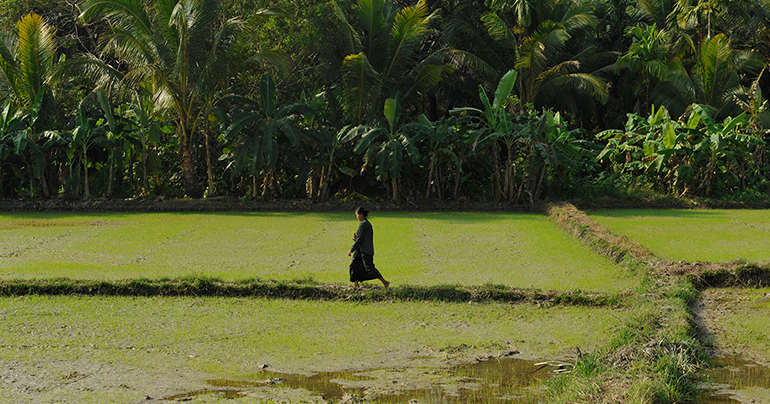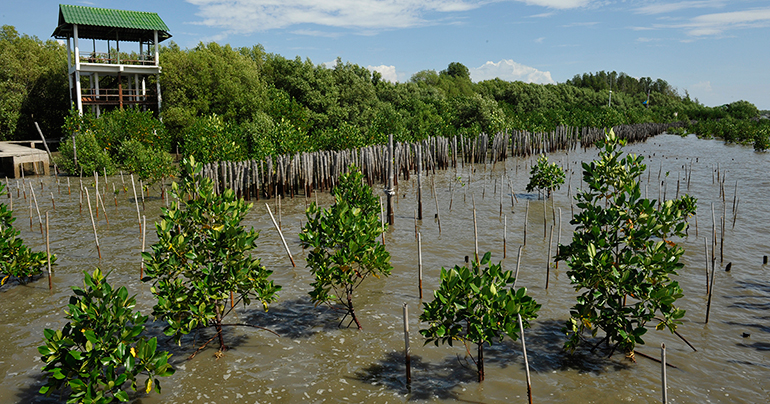The razing of Myanmar’s Ayeyarwady delta in May 2008 by cyclone Nargis and the devastation of the tsunami in the Indian Ocean in December 2004 might have been avoided if natural mangrove barriers between land and sea had been intact. They weren’t. The consequences were the loss of hundreds of thousands of lives and huge economic costs.

Unesco has designated 26 July 2018 as the inaugural International Day for the Conservation of the Mangrove Ecosystem – or, commonly, World Mangrove Day. It is a reminder that while they are extremely important to millions of people around the world, mangrove systems are among Earth’s most threatened ecosystems, with an estimated 67% of the world’s mangroves having already disappeared, according to the website Ocean Action Hub.
Paddling through a hot, humid and green mangrove forest will give you a glimpse of why these coastal forests are important. They are essential barriers against tsunamis and storms, they prevent shoreline erosion and they are a shelter for a vast array of life – they act as nurseries for newborn fish, which, when fully grown, help to sustain local people. People also collect medicinal plants, food and fruits from this ecosystem, which are essential to survival.
But mangroves are starting to vanish, in no small part due to human interference. A scientific paper published in 2016 found that Southeast Asia lost around 2% of its mangroves between 2000 and 2012. The study, by researchers at the National University of Singapore, found that the two main causes of mangrove destruction were aquaculture and rice farming – mainly from cultivation in Myanmar. The conversion of mangroves into oil palm plantations, common in Indonesia, Malaysia, Brunei and Thailand, was also cited as a considerable factor in the destruction of mangroves.
Daniel Friess, associate professor at the National University of Singapore and co-author of the 2016 study, doesn’t believe much has changed.
“It is my impression that trends today are similar to those reported between 2000 and 2012,” he said. [There has been] a general reduction in deforestation rates across the region compared to the late 20th century, but particular hotspots of concern [remain].”
Conversation and conservation
Japanese researchers observing the effects of the 2004 tsunami showed in 2009 that the destructive power of a six-meter-high wave could be reduced considerably if it encountered a mangrove barrier.
After the tsunami, governments in Southeast Asia started talking about the need for action – from the replanting of mangroves to creating new policies.
“Governments across Southeast Asia are now more strongly incorporating mangroves into national laws and policies, and creating cross-agency management committees to better manage their mangrove resources,” said Friess.

Friess stressed that the best way to tackle the problem is to preserve what’s already there.
“The cheapest and most efficient way to stop a decrease in mangrove forest area is to protect and conserve what we already have,” he said. “This can be achieved through land planning, proper enforcement and the creation of protected areas. The replanting of mangroves should be a last resort because it can be expensive and is often unsuccessful.”
While many academics and NGOs acknowledge the positive attitude from different governments, there are still challenges to be faced. Educating local communities on the importance of conserving mangroves is one important factor in reducing the rate that the ecosystems are being destroyed, said Steen Christensen, regional coordinator for Mangroves for the Future (MFF).
“Mechanisms for management of coastal resources need to be inclusive and empower local coastal communities in decision-making processes,” Christensen said. “For example, Indonesia, as well as other MFF partner countries, have focused on supporting local communities to restore and manage coastal mangroves that are the foundation of their livelihood. An important part of this work is raising awareness of the importance of conserving mangroves.”

World Mangrove Day
Despite an increase in dialogue surrounding the protection of mangroves, Unesco has called for further action to be taken.
To commemorate the new international day of mangrove recognition, Unesco director-general Irina Bokova said in a statement: “Mangroves are rare, spectacular and prolific ecosystems on the boundary between land and sea… Their survival faces serious challenges – from the alarming rise of the sea level and biodiversity that is increasingly endangered. The Earth and humanity simply cannot afford to lose these vital ecosystems.”
Bokova also called for an end to the destruction of mangroves: “On this first International Day for the Conservation of the Mangrove Ecosystem, Unesco’s message is clear. Taking forward the [UN’s] 2030 Agenda for Sustainable Development means forging new sustainable pathways to development in harmony with the earth. This means preserving all mangrove ecosystems.”


